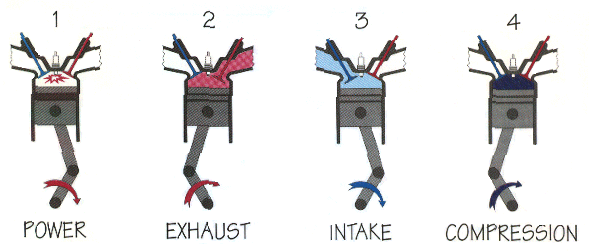Camshaft Tutorial |
| In an effort to simplify what actually happens inside
an motorcycle engine, V-Twin Café and Competition Cams invites you to
"take a walk" inside a typical engine, just like the one you might have in your
car. We will discuss valve events, piston position, overlap and centerlines. Although we
can not explain cam design in such a small space, we might be able to clear up some of the
most misunderstood terms and make clearer what actually happens as the engine goes through
its four-stroke cycle. We will graphically illustrate the relationship between all parts
of the engine and try to help you understand how the camshaft affects the power of the
engine. Put on your walking shoes, open your eyes and get ready for a good look inside
this engine.
We begin with the piston all the way at the top with both valves closed. Just a few degrees ago the spark plug fired and the explosion and the expansion of the gasses is forcing the piston towards the bottom of the cylinder. This is the event that actually pushes the crankshaft around to create the power and is referred to as the "power stroke" (figure 1). Each "stroke" lasts one half crankshaft revolution or 180 crankshaft degrees. Since the camshaft turns at half of the speed of the crank, the power stroke only sees one fourth of a turn of the cam, or 90 camshaft degrees. As we move closer to the bottom of the cylinder, a little before the piston reaches the bottom, the exhaust valve begins to open. By this time most of the charge has been burned and the cylinder pressure will begin to push this burnt mixture out into the exhaust port. After the piston passes the true bottom or Bottom Dead Center, it begins to rise back to the top. Now we have begun the exhaust stroke, another 180° in the cycle (figure 2). This forces the remainder of the mixture out of the chamber to make room for a fresh, clean charge of air-fuel mixture. While the piston is moving toward the top of the cylinder, the exhaust valve quickly opens, goes through maximum lift and begins to close. Now something quite unique begins to take place. Just before the piston reaches the top, the intake valve begins to open and the exhaust valve is not yet fully closed. This doesn't sound right, does it? Let's try to figure out what is happening. The exhaust stroke of the piston has pushed out just about all of the spent charge and as the piston approaches the top and the intake valve begins to open slowly, there begins a siphon or "scavenge" effect in the chamber. The rush of the gases out into the exhaust port will draw in the start of the intake charge. This is how the engine flushes out all of the used charge. Even some of the new gases escape into the exhaust. Once the piston passes through Top Dead Center and starts back down, the intake charge is being pulled in quickly so the exhaust valve must close at precisely the right point after the top to keep any burnt gas from reentering. This area around Top Dead Center with both valves open is referred to as "overlap". This is one of the most critical moments in the running cycle, and all points must be positioned correctly with the Top Dead Center of the piston. We'll look at this much more closely later. We have now passed through overlap. The exhaust valve has closed just after the piston started down and the intake valve is opening very quickly. This is called the intake stroke (figure 3), where the engine "breathes" and fills itself with another charge of fresh air/fuel mixture. The intake valve reaches its maximum lift at some defined point (usually about 106 degrees) after top dead center. This is called the intake centerline, which refers to where the cam has been installed in the engine in relation to the crankshaft. This is commonly called "degreeing". We will talk about this later also. The piston again goes all the way to the bottom and as it starts up, the intake valve is rushing towards the seat. The closing point of the intake valve will determine where the cylinder actually begins to build pressure, as we are now into the compression stroke (figure 4). When the mixture has all been taken in and the valves are both closed, the piston begins to compress the mixture. This is where the engine can really build some power. Then, just prior to the top, the spark plug fires and we are ready to start all over again. The engine cycle we have just observed is typical of all four- stroke engines. There are several things we have not discussed, such as lift, duration, opening and closing points, overlap, intake centerline and lobe separation angle. If you will refer to the valve timing diagram when we discuss these terms it might make things a lot easier to understand. © 1996 iXL |
